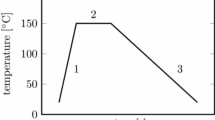The kinetic-equations method is used to obtain a constitutive equation of viscoelasticity based on representations of the existence of different conformational states of the macromolecules of oriented polymers. The equation makes it possible to describe and predict the stress-strain state of synthetic fibers and other polymeric materials under non-destructive loads.

Similar content being viewed by others
References
Yu. N. Rabotnov, Elements of Hereditary Solid Mechanics [in Russian], Nauka, Moscow (1977).
J. Ferry, Viscoelastic Properties of Polymers [Russian translation], Nauka, Moscow (1970).
T. Alfrey, Mechanical Properties of High Polymers [Russian translation], Izdatinlit, Moscow (1952).
A. M. Stalevich, Deformation of Oriented Polymers [in Russian], Izd. SPbGUTD, St. Petersburg (2002).
A. G. Makarov and A. V. Demidov, Method for Mathematical Modeling of the Mechanical Properties of Polymers [in Russian], Izd. SPbGUTD, St. Petersburg (2009).
I. I. Bugakov, Creep of Polymeric Materials [in Russian], Nauka, Moscow (1973).
V. S. Ekel’chik and V. M. Ryabov, Mekhanika Kompoz. Materialov, No. 3, 393-404 (1981).
A. G. Makarov and A. V. Demidov, Optimization of Methods for the Spectral Modeling of Polymer Deformation Processes [in Russian], Izd. SPbGUTD, St. Petersburg (2008).
A. V. Demidov, A. G. Makarov, and A. M. Stalevich, Mechanics of Solids, No. 44 (1), 122-130 (2009).
A. M. Stalevich and A. G. Makarov, Physical Chemistry of Polymers: Symposium. Tver University, Tver (1999), Vol. 5, pp. 58-64.
A. V. Demidov, A. G. Makarov, and A. M. Stalevich, J. Appl. Mechanics a. Techn. Phys., No. 48 (6), 897-904 (2008).>
P. P. Rymkevich, A. A. Romanova, et al., Izv. Vyssh. Uchebn. Zaved., Tekhnol. Leg. Prom-sti, 16, No. 2, 70-73 (2012).
Author information
Authors and Affiliations
Additional information
Translated from Khimicheskie Volokna, No. 1, pp. 31-35, January-February, 2014.
Appendix 1.
Appendix 1.
Appendix 2.
where we have introduced the following notation: γ*(H) is a structure-sensitive function;
Rights and permissions
About this article
Cite this article
Rymkevich, P.P., Gorshkov, A.S., Makarov, A.G. et al. Main Constitutive Equation of the Viscoelastic Behavior of Unixially Co-Oriented Polymers. Fibre Chem 46, 28–32 (2014). https://doi.org/10.1007/s10692-014-9555-z
Published:
Issue Date:
DOI: https://doi.org/10.1007/s10692-014-9555-z




